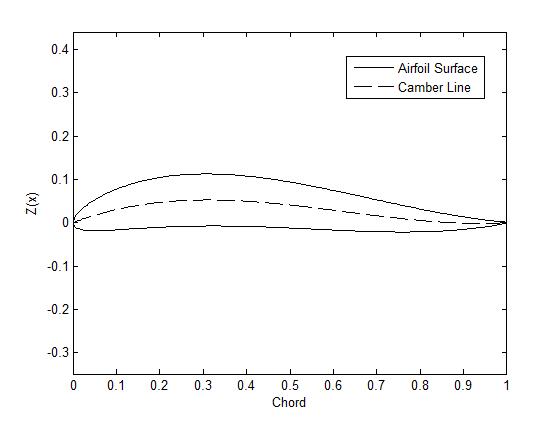Camber (aerodynamics) on:
[Wikipedia]
[Google]
[Amazon]
 In
In
 An airfoil where the camber line curves back up near the trailing edge is called a reflexed camber airfoil. Such an airfoil is useful in certain situations, such as with
An airfoil where the camber line curves back up near the trailing edge is called a reflexed camber airfoil. Such an airfoil is useful in certain situations, such as with
''Desktop Aerodynamics Digital Textbook''
Retrieved 9/7/08. * ''Theory of Wing Sections'', Ira H.Abbott and Albert E.Von Doenhoff (Dover Publications-1959) {{DEFAULTSORT:Camber (Aerodynamics) Aircraft aerodynamics Aircraft wing design
 In
In aeronautics
Aeronautics is the science or art involved with the study, design process, design, and manufacturing of air flight-capable machines, and the techniques of operating aircraft and rockets within the atmosphere.
While the term originally referred ...
and aeronautical engineering
Aerospace engineering is the primary field of engineering concerned with the development of aircraft and spacecraft. It has two major and overlapping branches: aeronautical engineering and astronautical engineering. Avionics engineering is s ...
, camber is the asymmetry between the two acting surfaces of an airfoil
An airfoil (American English) or aerofoil (British English) is a streamlined body that is capable of generating significantly more Lift (force), lift than Drag (physics), drag. Wings, sails and propeller blades are examples of airfoils. Foil (fl ...
, with the top surface of a wing (or correspondingly the front surface of a propeller blade) commonly being more convex (positive camber). An airfoil that is not cambered is called a ''symmetric airfoil''. The benefits of cambering were discovered and first utilized by George Cayley
Sir George Cayley, 6th Baronet (27 December 1773 – 15 December 1857) was an English engineer, inventor, and aviator. He is one of the most important people in the history of aeronautics. Many consider him to be the first true scientific ...
in the early 19th century.
Overview
Camber is usually designed into anairfoil
An airfoil (American English) or aerofoil (British English) is a streamlined body that is capable of generating significantly more Lift (force), lift than Drag (physics), drag. Wings, sails and propeller blades are examples of airfoils. Foil (fl ...
to raise its maximum lift coefficient
In fluid dynamics, the lift coefficient () is a dimensionless quantity that relates the lift generated by a lifting body to the fluid density around the body, the fluid velocity and an associated reference area. A lifting body is a foil or a co ...
CLmax. This minimizes the stalling speed of aircraft using the airfoil. An aircraft with wings using a cambered airfoil will have a lower stalling speed than an aircraft with a similar wing loading
In aerodynamics, wing loading is the total weight of an aircraft or flying animal divided by the area of its wing. The stalling speed, takeoff speed and landing speed of an aircraft are partly determined by its wing loading.
The faster an airc ...
and wings using a symmetric airfoil.
One recent cambered design is called the supercritical airfoil. It is used for near-supersonic flight and produces a higher lift-to-drag ratio at near supersonic flight than traditional airfoils. Supercritical airfoils employ a flattened upper surface, highly cambered (curved) aft section, and greater leading-edge radius as compared to traditional airfoil shapes. These changes delay the onset of wave drag
In aeronautics, wave drag is a component of the aerodynamic drag
In fluid dynamics, drag, sometimes referred to as fluid resistance, is a force acting opposite to the direction of motion of any object moving with respect to a surrounding flu ...
.
Definition
An airfoil is said to have a positive camber if its upper surface (or in the case of a driving turbine or propeller blade its forward surface) is the more convex. Camber is a complex property that can be more fully characterized by an airfoil's camber line, the curve ''Z(x)'' that is halfway between the upper and lower surfaces, and thickness function ''T(x)'', which describes the thickness of the airfoils at any given point. The upper and lower surfaces can be defined as follows: : :Example – An airfoil with reflexed camber line
 An airfoil where the camber line curves back up near the trailing edge is called a reflexed camber airfoil. Such an airfoil is useful in certain situations, such as with
An airfoil where the camber line curves back up near the trailing edge is called a reflexed camber airfoil. Such an airfoil is useful in certain situations, such as with tailless aircraft
In aeronautics, a tailless aircraft is a fixed-wing aircraft with no other horizontal aerodynamic surface besides its main wing. It may still have a fuselage, vertical tail fin (vertical stabilizer), and/or vertical rudder.
Theoretical advanta ...
, because the moment about the aerodynamic center of the airfoil can be 0. A camber line for such an airfoil can be defined as follows (''note that the lines over the variables indicates that they have been nondimensionalized by dividing through by the chord''):
:
An airfoil with a reflexed camber line is shown at right. The thickness distribution for a NACA 4-series airfoil was used, with a 12% thickness ratio. The equation for this thickness distribution is:
:
Where ''t'' is the thickness ratio.
See also
* Chord *NACA airfoil
The NACA airfoil series is a set of standardized airfoil shapes developed by this agency, which became widely used in the design of aircraft wings.
Origins
NACA initially developed the numbered airfoil system which was further refined by the Un ...
* Aerodynamic drag
In fluid dynamics, drag, sometimes referred to as fluid resistance, is a force acting opposite to the direction of motion of any object moving with respect to a surrounding fluid. This can exist between two fluid layers, two solid surfaces, or b ...
* Zero-lift axis
References
;Sources''Desktop Aerodynamics Digital Textbook''
Retrieved 9/7/08. * ''Theory of Wing Sections'', Ira H.Abbott and Albert E.Von Doenhoff (Dover Publications-1959) {{DEFAULTSORT:Camber (Aerodynamics) Aircraft aerodynamics Aircraft wing design